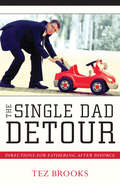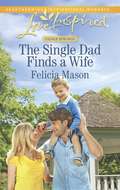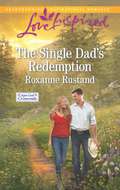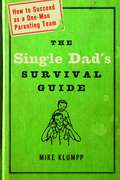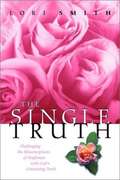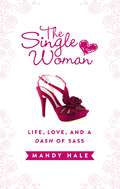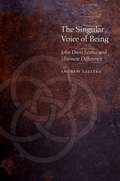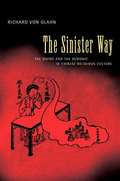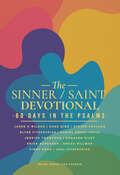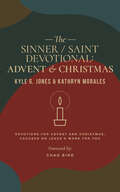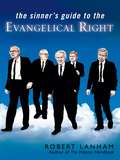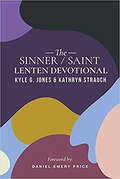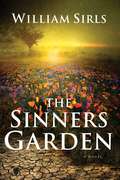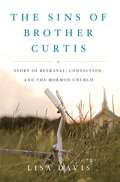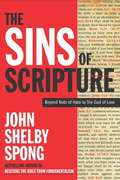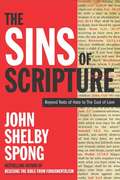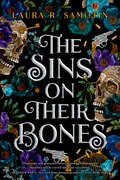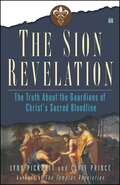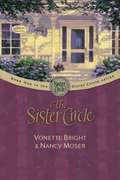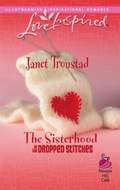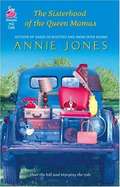- Table View
- List View
The Single Dad Detour: Directions for Fathering After Divorce
by Tez BrooksConventional wisdom holds that fathers have few parenting skills and that mothers always know best. The single father is often considered a mythical creature, found only in sitcoms as an object of humor or pity. Where does that leave real single dads? Too often, it makes them susceptible to overcompensation or apathy. Tez Brooks knows those feelings all too well. He's traveled that road with his own children after an unexpected divorce. The Single Dad Detour is the result of his journey and the lessons he's learned along the way. It's a guidebook for the rocky road of single fatherhood, extending encouragement, confidence, and challenges, using specific examples from dads who've survived parenting and have hope to offer. There are no unreachable requirements for perfect fatherhood here and no twisty theological mysteries--just authentic, downto- earth wisdom from one dad to another.
The Single Dad Finds a Wife
by Felicia MasonThe Doctor's New Family Doctor Spring Darling has everything she needs. A wonderful family and a busy job helping the children of Cedar Springs, North Carolina. She's given up on adding love to that mix. Until the moment David Camden and his adorable son appear in her exam room. Spring assumes David is another down-on-his-luck single parent at the free clinic-but looks can be deceiving. Because David has a job-he's the architect proposing a new development in the middle of Spring's land! When the truth is revealed, can Spring find a way to keep both her home and the blessing of new love?eiving. Because David has a job-he's the architect proposing a new development in the middle of Spring's land! When the truth is revealed, can Spring find a way to keep both her home and the blessing of new love?
The Single Dad Next Door: A Fresh-Start Family Romance (Goose Harbor #3)
by Jessica KellerLove Comes Home All Maggie West has ever wanted is a family to call her own. But her new neighbor, single dad Kellen Ashby, is definitely not the man to make that dream come true. His daughters are sweet and silly, the kind of kids Maggie used to imagine having herself. But Kellen has just inherited the inn Maggie manages-her former family home-and the two butt heads at almost every turn. He's handsome, and clearly a devoted father, but with all the changes taking place, Maggie worries she may soon be jobless, homeless or both. At war with her emotions, Maggie will have to decide what truly matters-heart or home.
The Single Dad's Redemption
by Roxanne RustandThe Cowboy's Second Chance With the town's busiest sales weekend on the horizon, store owner Keeley North is desperate to find help. So when Connor Rafferty walks through her door, he's an unlikely answer to her prayers. The former rodeo star may be a fish out of water in her shop, but he can rise to any challenge. And right now he's set his sights on finding the son he hasn't seen in five years. Keeley can't risk her heart on a scarred cowboy who's searching for something more. But if she can convince him to look beyond the mistakes of his past, Connor may get a second chance to have it all.
The Single Dad's Survival Guide: How to Succeed as a One-Man Parenting Team
by Michael A. KlumppYou May Be Single, But You're Not Alone. Being a great dad is challenging enough when you're part of a two-person team. But now you're raising your kids single-handedly. How can you provide the emotional, physical, and spiritual support your children need, cover all the details of running a household, and still earn a living to support your family? Being a solo dad could easily be the toughest job of your life. The good news is you're not alone. Inside this book you'll find the support, advice, and encouragement you need to succeed. Here are practical solutions for everything you're facing-from conflicting emotions to day-to-day time management. You'll find useful pointers on a daughter's unique needs, a son's inner struggles, and even how to recruit trusted friends to pitch in. With plenty of humor and real-world insight, The Single Dad's Survival Guide will show you how to expand on your natural, built-in abilities so you can come out on top as a parenting team of one. * Find logistical help on everyday challenges, including finances, family schedules, household management, and staying on top of your work. * Take advantage of practical guidance on everything from supporting and nurturing your kids to protecting your own emotional health.* Learn how to get past anger, hurt, and fatigue to stand strong as the man your children need most-a man who provides security, stability, and spiritual guidance during one of the toughest times in their life. It's all here to help you succeed as a solo dad. Single parenting takes everything you've got-so learn how to give it your all.From the Trade Paperback edition.
The Single Truth: Challenging the Misconceptions of Singleness with God's Consuming Truth
by Lori SmithIf you are single and struggling with its attendant "stigma," The Single Truth offers you God's liberating truths about singleness. Lori Smith clears away the fog and lies surrounding singleness and challenges you to live a full life and to see your singleness as a part of God's good plan. She powerfully affirms that: You are deeply loved by God. Marriage isn't better or worse-it's different. You have no need to be ashamed about your singleness. You can be content.
The Single Woman–Life, Love, and a Dash of Sass: Embracing Singleness with Confidence
by Mandy HaleSmart, strong, independent—single women can live a fabulous life. Husband not required. Mandy Hale, also known by her many blog readers and Twitter fans as The Single WomanTM, shares her stories, advice, and enthusiasm for living life as an empowered, confident, God-centered woman who doesn’t just resign herself to being single—she enjoys it! Being single has had its stigmas, but Mandy proves it has its advantages too, and she uses wisdom and wit to inspire her fellow single ladies to celebrate and live fully in the life God has given them. Mandy encourages her readers on subjects such as taking chances, building friendships, letting go, and finding a greater purpose. With her help, readers can stop worrying about happily ever after and discover a happy life instead.
The Singular Voice of Being: John Duns Scotus and Ultimate Difference (Medieval Philosophy: Texts and Studies)
by Andrew T. LaZellaThe Singular Voice of Being reconsiders John Duns Scotus’s well-studied theory of the univocity of being in light of his less explored discussions of ultimate difference. Ultimate difference is a notion introduced by Aristotle and known by the Aristotelian tradition, but one that, this book argues, Scotus radically retrofits to buttress his doctrine of univocity. Scotus broadens ultimate difference to include not only specific differences, but also intrinsic modes of being (e.g., finite/infinite) and principles of individuation (i.e., haecceitates). Furthermore, he deepens it by divorcing it from anything with categorical classification, such as substantial form. Scotus uses his revamped notion of ultimate difference as a means of dividing being, despite the longstanding Parmenidean arguments against such division. The book highlights the unique role of difference in Scotus’s thought, which conceives of difference not as a fall from the perfect unity of being but rather as a perfective determination of an otherwise indifferent concept. The division of being culminates in individuation as the final degree of perfection, which constitutes indivisible (i.e., singular) degrees of being. This systematic study of ultimate difference opens new dimensions for understanding Scotus’s dense thought with respect to not only univocity, but also to individuation, cognition, and acts of the will.
The Sinister Swaps (Church Choir Mysteries #7)
by Evelyn MinshullWelcome to Willow Bend, the home of feisty red-headed widow Gracie Lynn Parks, choir member, master chef, and sleuth. With the help of her friends in the choir of Eternal Hope and her cat, Gracie unravels mysteries while cooking and praying to God. Everyone at Eternal Hope is mystified by strange ransom notes for lollipops and flowers and Christmas in the summer, and Gracie tries to get to the bottom of it. Getting involved in young Lacey’s concern about her grandmother’s health, she gets more than she bargained for. Uncle Miltie tries to avoid an admirer, and a French chef wants Gracie’s “secret” recipe. The town of Willow Bend is abuzz with news, and a picnic lunch is just the place to unravel a mystery.
The Sinister Way: The Divine and the Demonic in Chinese Religious Culture
by Richard Von GlahnA survey of Chinese religion from 1000 BC to the beginning of the 20th century, as well as a study of the ambiguities of divine power in Chinese religion.
The Sinner / Saint Devotional: 60 Days in the Psalms (The Sinner/Saint Devotional Series)
by Daniel Emery PriceThere is a Psalm for just about everything. Defeated? It's there. Joyful? That's is there too. Angry with God? There are a lot of Psalms for that. Some of them give us great comfort, and some of them make us uncomfortable, but in the end, all of them point us to Jesus.This is a 60-day devotional that deals with us right where we are because that is where the Psalms deal with us. You won't find a bunch of platitudes or Christian fluff. The Psalms are too gritty and honest for that. This devotional is written by and for real sinners in daily need of a God offering real promises of forgiveness, grace, and hope.
The Sinner / Saint Devotional: Advent and Christmas (The Sinner/Saint Devotional Series)
by Kyle G Jones Kathryn MoralesThe day after Halloween, everything around us— ads, store displays, music, and the like— put us on notice: Christmas is coming. With the announcement of Christmas's imminent arrival comes work, work, and more work. We mutter under our breath for lazily storing the Christmas lights in a tangle; we wring our hands over finding good gifts and planning the perfect Christmas meal; every major checklist item includes dozens of decisions and subtasks, each with their own obstacles and pressures to complete. The biggest checklist item: completing all your work with Christmas cheer. In this pressuring cooker of Christmas preparations, The Sinner/Saint Devotional: Advent and Christmas walks you through these church seasons, shifting your focus from work and checklists and putting it on the work Jesus did and does for you.Each devotion includes an opening Scripture passage, a devotional thought, a closing prayer, and a suggested Scripture reading for further reflection. They present you with the Gospel of Advent and Christmas: how Christ has come for us and will come for us again. You will be reminded repeatedly that these seasons are not mere past events to remember, but comfort for today. Comfort from the God who keeps his promises and sent his Son for the forgiveness of our sins.
The Sinner's Guide to the Evangelical Right
by Robert LanhamFrom Bibles designed to look like glossy fashion magazines to mega-churches with ATMs, rock climbing walls, and in one case, a drive-thru McDonalds, the nuances of conservative evangelical culture are no mystery to Robert Lanham, who has his roots in the Bible Belt. Now, with his anthropological eye and trademark wit, Lanham has compiled a handy guide to the evangelical right for those who can expect to be left behind in the End of Days.
The Sinner/Saint Lenten Devotional (The Sinner/Saint Devotional Series)
by Kyle G Jones Kathryn MoralesDuring the forty days of Lent, we explore the gift of repentance that turns us back to Christ and his finished work. There is no repentance apart from Christ. There is no Lent apart from Christ's suffering on our behalf. There is no hope apart from his righteousness gifted to us. All of these daily devotions are written with these great truths in mind. Dear Sinner/Saint, prepare to be told in these pages to go home to your forgiving Father over and over.* Foreword by Daniel Emery PriceEach day featuresa bible passagereflectionshort prayersuggestions for further reading
The Sinners' Garden
by William SirlsIn the small Lake Erie township of Benning, someone is at work cultivating a supernatural garden ...Andy Kemp's young life has been as ravaged as his scarred face. Disfigured by an abusive father, the teenager hides behind his books and an impenetrable wall of cynicism and anger.As Andy's mother struggles to reconnect with him, his Uncle Rip returns transformed from a stint in prison and wants to be a mentor to the reclusive boy, doing everything he can to help end Andy's pain. When Andy begins hearing strange music through his iPod and making near-prophetic announcements, Rip is convinced that what Andy is hearing is the voice of God. Elsewhere, police officer Heather Gerisch responds to a late-night breaking and entering in one of the poorest homes in town. She soon realizes that the masked prowler has left thousands of dollars in gift cards from a local grocery store. As the bizarre break-ins continue and Heather pursues the elusive "Summer Santa," Andy and Rip discover an enormous and well-kept garden of wildflowers that seems to have grown overnight at an abandoned steel mill. Soon, they realize who the gardener is, and a spree of miracles transfigures this small town from a place of hopelessness into a place of healing and beauty.
The Sins of Brother Curtis
by Lisa DavisThis brilliantly reported, unforgettable true story reveals how one of the most monstrous sexual criminals in the history of the Mormon church preyed on his victims even as he was protected by the church elders who knew of his behavior.When Seattle attorney Tim Kosnoff agreed to listen to an eighteen-year-old man who claimed to have been molested by his Mormon Sunday school teacher, he had no idea he was embarking on a quest for justice on behalf of multiple victims or that the battle would consume years of his life and pit him against the vast, powerful, and unrepentant Mormon church itself. As Kosnoff began to investigate the case, he discovered that the Sunday school teacher, a mysterious figure named Frank Curtis, possessed a long and violent prison record before he was welcomed into the church, where he became a respected elder entrusted with the care of prepubescent Mormon boys. Through Lisa Davis's deft storytelling, two astonishing narratives unfold. The first shows how Brother Curtis ingratiated himself into the lives of young boys from working-class Mormon families where money was tight, and was accepted by mothers and fathers who saw in him a kindly uncle or grandfather figure who enjoyed the blessing of the church. Having gained the families' trust, Curtis became fiendishly helpful, offering to supervise trips or overnights out of the sight of parents, when he could manipulate his victims or ply them with alcohol. The other narrative is a real-life legal thriller. As Davis shows, Kosnoff and his partners tirelessly assembled the case against the church, sifting through records, tracking down victims, and convincing them to testify about Brother Curtis's acts. What began as a case of one plaintiff turned into a complex web stretching across multiple states. Joined by what would become a team of attorneys and investigators, Kosnoff found himself up against one of the most insular institutions in the United States: the secretive and powerful Mormon church. The amazing legal case at the heart of The Sins of Brother Curtis shows how the church's elite, well-funded team of attorneys claimed the church was protected under the Constitution from revealing that Curtis had molested a number of Mormon boys. Yet Kosnoff and his devoted legal team (which included a female investigator adept at getting parents of victims to talk to her) succeeded in forcing the church to reveal that it knew about Curtis and ultimately achieved a successful settlement. Emotionally powerful page by page, The Sins of Brother Curtis delivers a redemptive reading experience in which the truth, no matter how painful and hidden, is told at last and justice is hard won. This is a remarkable story, all true.
The Sins of Scripture
by John Shelby SpongIn the history of the Western World, the Bible has been a perpetual source of inspiration and guidance for countless Christians. However, this Bible has also left a trail of pain. It is undeniable that the Bible is not always used for good. Sometimes the Bible can seem overtly evil. Sometimes its texts are terrible. Bishop John Shelby Spong boldly approaches those texts that have been used through history to justify the denigration or persecution of others while carrying with them the implied and imposed authority of the claim that they were the "Word of God." As he exposes and challenges what he calls the "terrible texts of the Bible", laying bare the evil done by these texts in the name of God, he also seeks to redeem these texts, hoping to recover their ultimate depth and purpose. Spong looks specifically at texts used to justify homophobia, anti-Semitism, treating women as second-class humans, corporal punishment, and environmental degradation, but he also delivers a new picture of how Christians can use the Bible today. As Spong battles against the way the Bible has been used throughout history, he provides a new framework, introducing people to a proper way to engage this holy book of the Judeo-Christian tradition.
The Sins of Scripture: Exposing the Bible's Texts of Hate to Reveal the God of Love
by John Shelby SpongSpong, an Episcopal bishop, shares his views on Bible passages that have been wrongly used to discriminate or oppress. He asserts that such interpretations distort the truth of Christianity and do not accurately represent God's love.
The Sins on Their Bones
by Laura R. SamotinSet in a Jewish folklore-inspired reimagining of 19th century Eastern Europe, this queer dark fantasy debut pits two estranged husbands and a daring spymaster on opposite sides of a civil war. Perfect for fans of Leigh Bardugo, C.S. Pacat, and Katherine Arden.Dimitri Alexeyev used to be the Tzar of Novo-Svitsevo. Now, he is merely a broken man, languishing in exile after losing a devastating civil war instigated by his estranged husband, Alexey Balakin. In hiding with what remains of his court, Dimitri and his spymaster, Vasily Sokolov, engineer a dangerous ruse. Vasily will sneak into Alexey&’s court under a false identity to gather information, paving the way for the usurper&’s downfall, while Dimitri finds a way to kill him for good.But stopping Alexey is not so easy as plotting to kill an ordinary man. Through a perversion of the Ludayzim religion that he terms the Holy Science, Alexey has died and resurrected himself in an immortal, indestructible body—and now claims he is guided by the voice of God Himself. Able to summon forth creatures from the realm of demons, he seeks to build an army, turning Novo-Svitsevo into the greatest empire that history has ever seen.Dimitri is determined not to let Alexey corrupt his country, but saving Novo-Svitsevo and its people will mean forfeiting the soul of the husband he can&’t bring himself to forsake—or the spymaster he&’s come to love.
The Sins on Their Bones: Book One of The Cursed Crown series (The Cursed Crown Duology)
by Laura R. SamotinSet in a Jewish folklore-inspired reimagining of 19th century Eastern Europe, this queer dark fantasy debut pits two estranged husbands and a daring spymaster on opposite sides of a civil war. Perfect for fans of Leigh Bardugo, C.S. Pacat, and Katherine Arden.Dimitri Alexeyev used to be the Tzar of Novo-Svitsevo. Now, he is merely a broken man, languishing in exile after losing a devastating civil war instigated by his estranged husband, Alexey Balakin. In hiding with what remains of his court, Dimitri and his spymaster, Vasily Sokolov, engineer a dangerous ruse. Vasily will sneak into Alexey&’s court under a false identity to gather information, paving the way for the usurper&’s downfall, while Dimitri finds a way to kill him for good.But stopping Alexey is not so easy as plotting to kill an ordinary man. Through a perversion of the Ludayzim religion that he terms the Holy Science, Alexey has died and resurrected himself in an immortal, indestructible body—and now claims he is guided by the voice of God Himself. Able to summon forth creatures from the realm of demons, he seeks to build an army, turning Novo-Svitsevo into the greatest empire that history has ever seen.Dimitri is determined not to let Alexey corrupt his country, but saving Novo-Svitsevo and its people will mean forfeiting the soul of the husband he can&’t bring himself to forsake—or the spymaster he&’s come to love.
The Sion Revelation: The Truth About the Guardians of Christ's Sacred Bloodline
by Lynn Picknett Clive PrinceAn essential notion in the #1 New York Times bestseller The Da Vinci Code is the existence of an age-old French society, the Priory of Sion, whose task it is to protect Christ's sacred bloodline. In The Sion Revelation, Picknett and Prince reveal the story of the Priory, taking readers on a highly significant, disturbing, and even alarming ride through history into an intriguing world where a great many uncomfortable facts will have to be faced, both religious and political. Drawing on a wealth of astonishing evidence, they answer numerous questions that shroud this society, including: Does the Priory actually exist or is the group's entire history an elaborate hoax? Was Leonardo da Vinci really one of the Priory's Grand Masters? What is the truth behind Pierre Plantard, the enigmatic French aristocrat who claimed to be a Priory Grand Master -- and who some claim was a Nazi sympathizer? Could the Priory be a front for other occult societies in Europe with religious or even political agendas? By carefully untangling centuries of obfuscation, rumor, and documented fact, The Sion Revelation unravels the great intricacies of this secret society and takes us on a historical journey that is as groundbreaking in its explanation as it is riveting in its telling.
The Sister Circle (The Sister Circle # #1)
by Nancy Moser Vonette BrightThe Sister Circle, book one of this charming contemporary series, introduces Peerbaugh Place, the quaint Victorian house that becomes a refuge to seven women of vastly different ages, personalities, and backgrounds. Through struggles and triumphs, the women forge a special bond of sisterhood. Readers will find their own place in the circle, gaining insight into their own spiritual gifts, as they laugh and cry with each of these women.
The Sisterhood of the Dropped Stitches (Sisterhood of the Dropped Stitches #1)
by Janet TronstadThree teenage friends, living with cancer meet and form a knitting group and are still together after five years. They each form a goal. Will they be able to meet the goals they have established?
The Sisterhood of the Queen Mamas
by Annie JonesMeet Maxine and Odessa, the Queen Mamas of Castlerock, Texas. They may be getting on in years, but good luck keeping up with them! Most days they're on the prowl at the Five Acres of Fabulous Finds Flea Market, searching for treasures among the trash, and turning life on its heels for: Jan, the "perfect" former cheerleader with a big secret * Bernadette, the bridal shop owner who seems destined for singlehood * Chloe, the trouble magnet needing fashion intervention... and a boyfriend makeover
The Sisterhood: How the Power of the Feminine Heart Can Become a Catalyst for Change and Make the World a Better Place
by Bobbie HoustonAs Co-founder and Senior Pastor of Hillsong Church and founder of The Colour Sisterhood, Bobbie Houston paints a vision of God's plan for women of all ages and backgrounds to flourish, empower each other, and unite to change the world. We don't need to look far to realize that not all women live with the same opportunities and confidence. THE SISTERHOOD invites women to explore and expand what they believe about God, themselves, and their responsibility to the world around them. Tracing the rise of Hillsong Church's global Sisterhood movement, author Bobbie Houston challenges women to join her in creating a new era of outreach. Readers will learn how to embrace their individual gifts and value as women, growing seeds of change into greater possibilities for women everywhere. If one woman can change her world, then only heaven truly knows what an entire company of women can achieve.
